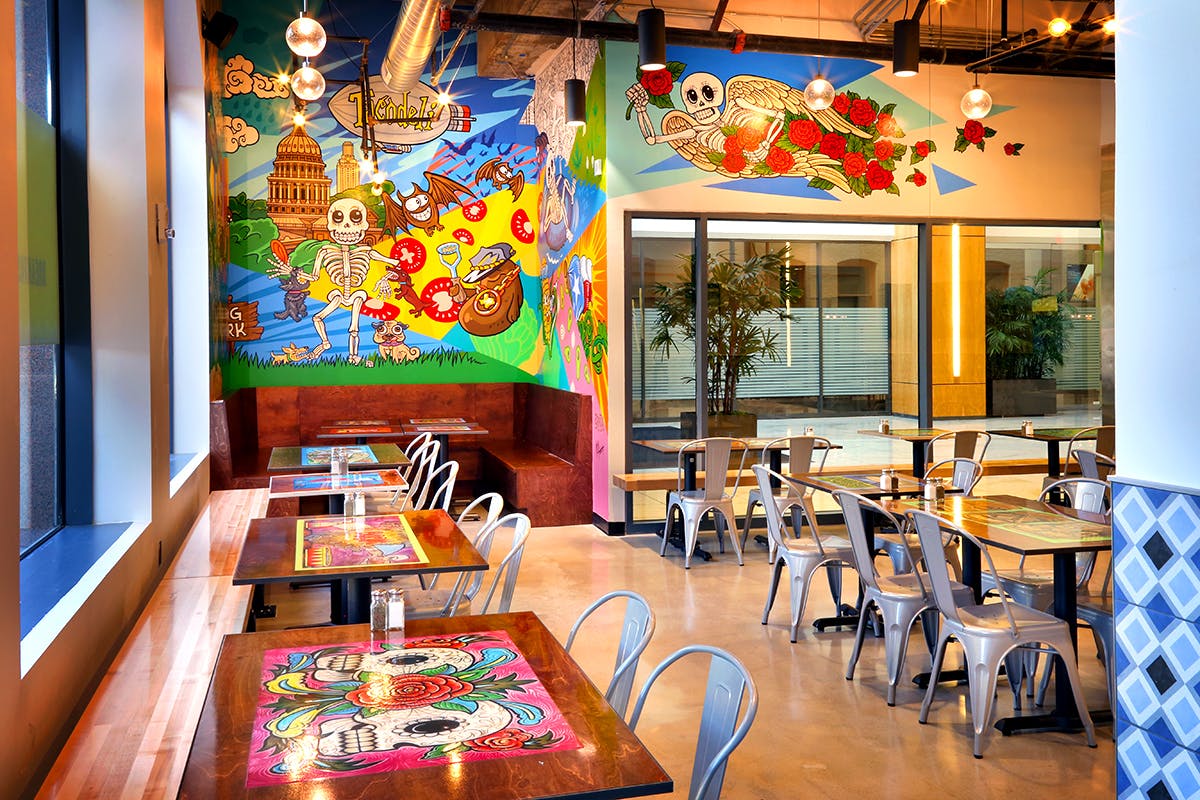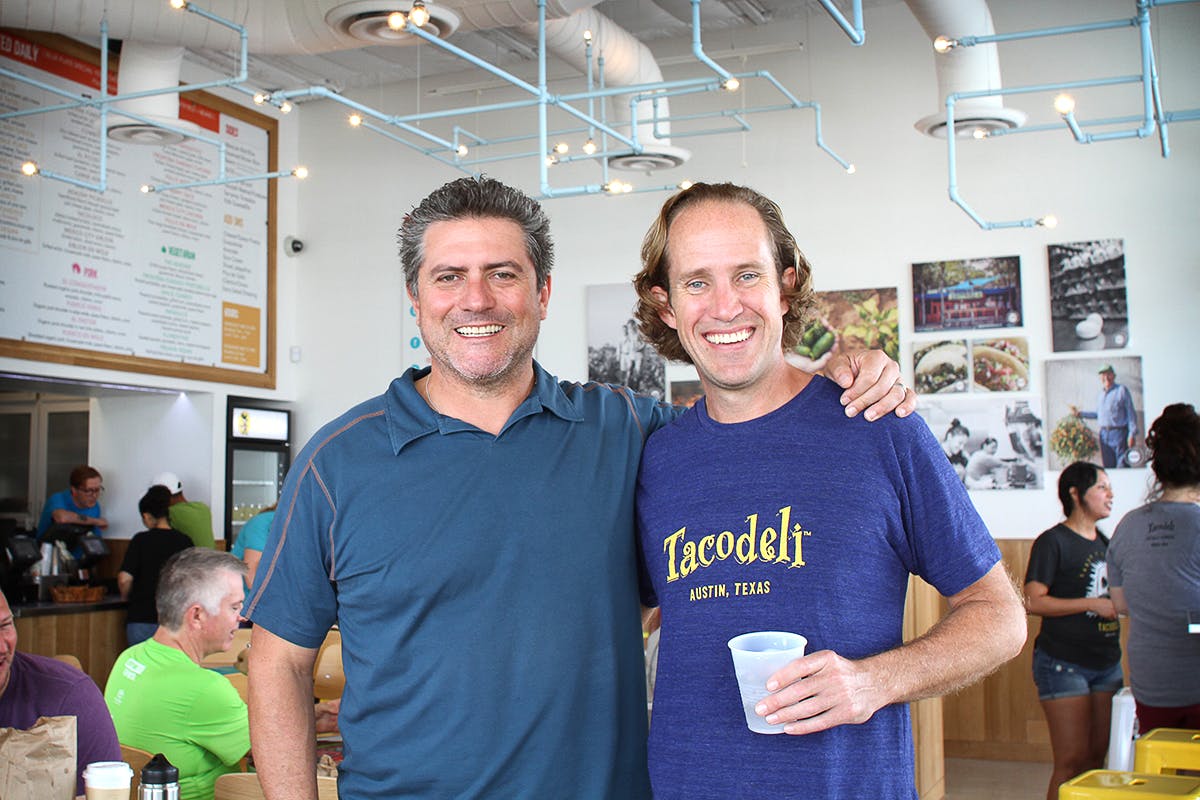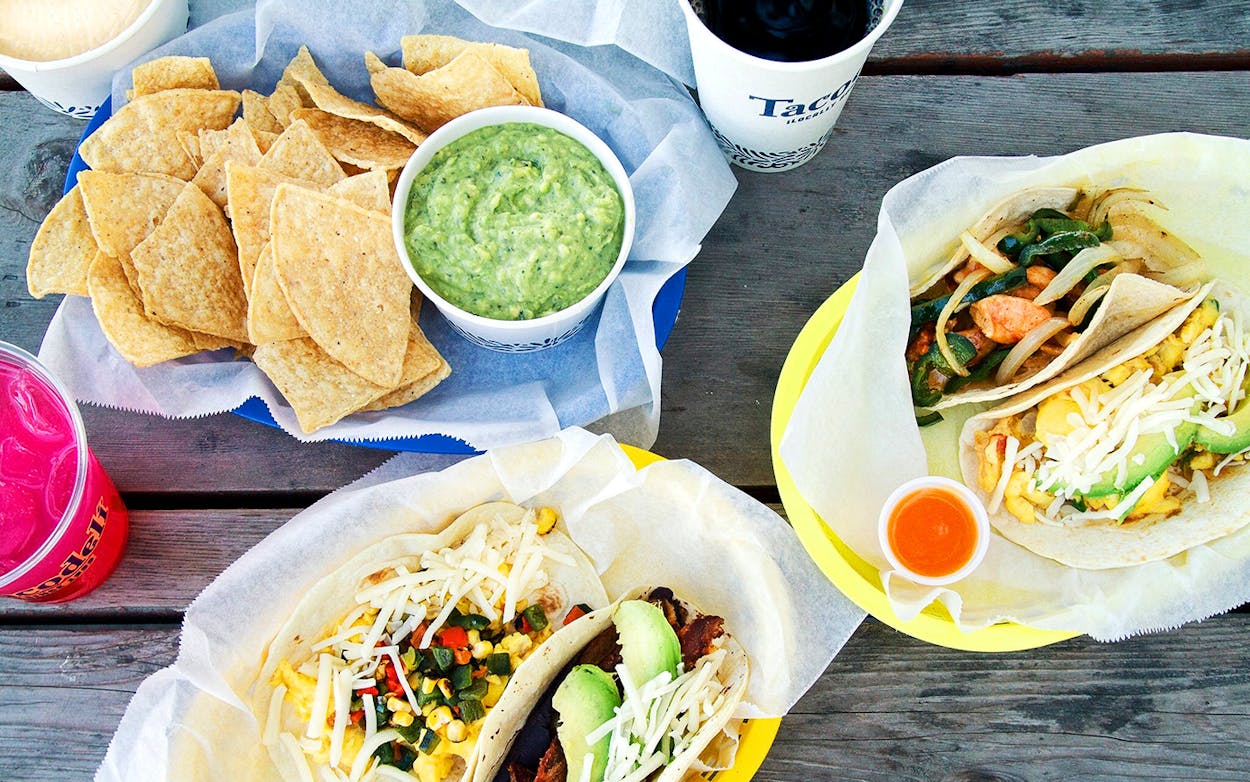Tacodeli co-owners Roberto Espinosa and Eric Wilkerson attended the University of Texas in the early nineties. They both lived and worked in Atlanta after graduation before returning to Austin. And they shared a mutual friend who tried to connect them. But they didn’t meet until after Espinosa opened the original Tacodeli location on Spyglass Drive in 1999. When Wilkerson went to add Espinosa to his contact list, it was already there, albeit with an Atlanta number, thanks to that mutual friend. “I guess it was meant to be,” Wilkerson says.
Over the past twenty years, Tacodeli—which opened with a small menu of tacos, tortas, wraps(!), and salads—has expanded its options and continuously emphasized the importance of local sourcing while moving beyond its hometown. It now has six locations in Austin (including the new spot downtown on Congress Avenue) as well as two branches in Dallas, two in Plano, and one in Houston.
While items have come and gone from the menu, the selections at Tacodeli have always been rooted in Mexican culinary traditions, especially in the food that Espinosa grew up with in his native Mexico City. This includes Tacodeli’s signature potato preparation and the home-style tacos de guisados. “My mom would go to the neighborhood mercado every Wednesday,” Espinosa says. “That’s how you sourced in Mexico when I was growing up.” In a way, Tacodeli gave customers a glimpse of what was to come in modern Mexican cuisine, right down to the organic corn masa from Fiesta Tortillas used at the Austin locations. The Dallas and Houston branches use tortillas from Tortilleria la Norteña, in Dallas.
To commemorate Tacodeli’s twentieth anniversary, I chatted with Espinosa and Wilkerson about the restaurant’s origins, the Salsa Doña, what they’re not good at, and more. The interview has been edited for length and clarity.

Texas Monthly: Congratulations on twenty years of Tacodeli. What’s the exact date of the anniversary?
Roberto Espinosa: November 8 was the first day of operation back in 1999. Eric joined sometime in the middle of the next year.
Eric Wilkerson: [Laughs.] Yeah, I was eating a lot of the tacos, and Roberto was hiring.
RE: We had a lot of cold beers talking about business, and that’s how Eric and I got to really connect.
TM: What were the original tacos on the menu?
RE: The Frontera chicken and beef; the “Fundido” part was [later] when we put the cheese glaze on it. So it was originally just the chicken and beef; it was our version of fajita. We use sirloin flap meat, which back then was not a hugely popular cut. We had our al pastor, a chicken adobado taco, and a rajas taco. And of course, the breakfast tacos have always been a mainstay. We had a poblano taco, too, which we don’t carry anymore. It was a battered and fried cheese-filled poblano chile on a taco.
TM: What you described, a battered and fried cheese-stuffed poblano chile in a tortilla is a chile relleno taco, a relatively rare taco in Texas. But you’re saying you had a chile relleno taco on the first Tacodeli menu?
RE: Exactly. It was a complicated taco because we had to fry those things up, and we don’t have a fryer. So, we always had to do a stove-top fry kind of job. It was a little bit labor intensive. Man, it was delicious.


TM: Unlike a lot of other taqueria’s potatoes, Tacodeli potatoes are mashed. Why?
RE: [Laughs.] It’s a little polarizing. You know, some people just don’t like the mashed potatoes, but we love them, and we have a huge following of customers that come in and eat the potatoes. My grandma made a mean plate of mashed potatoes, and she lived in Mexico City her entire life.
TM: The current Tacodeli menu is huge. How soon after opening and how soon after you came on board, Eric, did the menu expand?
EW: Early on, the process was very informal. Roberto and some of the team would come up with something or just try something different. We would eat it and share it with some of our guests. We would do a little trial and error. It was kind of a democratic process, but we were slowly but surely trying new specials. If they were popular, we would put them on the menu. It’s something that we’ve always done. And I guess what we’re not very good at is menu review; we have a hard time letting go of some of the tacos. As I look at the old menu, I count about maybe ten tacos. This breakfast taco menu looks so simple: migas and your choice of egg and bacon, potato, chorizo, beans, or cheese. I mean that’s just hard to believe when you think about it now.
RE: We want to keep a foot in the Mexican food tradition and use that as our barometer and interpret food with that in mind. Then we can get creative, and we can kind of create something that has a Tacodeli stamp. That way the story retains a level of the authenticity that I feel we need … that’s always been a really strong driving force for us.
TM: You guys go a long way to work with Texas purveyors. When did that start and why?
RE: The sourcing has always been very important. I think it was just an instinctive kind of decision. I remember early on when the farmers’ markets started [in Austin], we would start to try to source eggs—that was back in the early 2000s. Prices were so high that it was really hard to justify going in that direction. But we kept trying. And little by little, we’ve been able to achieve that. It’s something that we’re proud of. And that’s another reason why we make everything in house from scratch. Nothing has crazy ingredients in it. We know what’s in it. So that’s always been kind of part of our mentality. It was really hard early on.

EW: One thing I was going to say is that you know, the better the ingredients and the better the quality of the proteins or the vegetables or whatever, the less you really need to do to the food. Like Roberto said, we don’t have fryers. We don’t add a bunch of crazy ingredients to a subpar piece of meat to make it palatable. So I think there’s elegance and simplicity, and there’s the flavor and just how you feel after eating. It goes a long way. We do eat the tacos pretty much every day and, like a lot of other people, as we get a little older we just get a little more conscious of what we’re putting into our bodies.
TM: Last year, you added huevos ahogados—drowned scrambled eggs—to the permanent menu. That was a special of the moment that quickly made it to the regular menu. What was the thinking behind that decision?
RE: Two words: Customer demand. I mean we had so many requests for that. It was a taco that one of our team members would cook as a breakfast for the teams while they were training. We always looked forward to eating it. I said, “We need to put this on the [specials] board, man. It’s so good. And we put it on the board and it was a hot seller. We have a customer at one of our Austin locations named Carl who is in there almost every morning. Every time I saw him, he’d be like, “Roberto, don’t get rid of the huevos ahogados. Put it on the menu.” He wasn’t the only one, but he was probably the most vocal.
TM: Customers are also very passionate about your Doña salsa. My 11-year-old son, for example, keeps a container of it in our fridge. He puts the salsa on everything. Can you recount the story of the Doña salsa?
RE: You know it was early on. It was just Spyglass, 740 square feet, a nice little restaurant, and I was getting my feet under me. I was learning what it was to have a team and create food and all that, and I wanted to see what our team members’ capabilities and kitchen abilities were. I announced that I was going to have a contest, and the winner would win X amount of money. I’m embarrassed to even say what the amount was—it was a contest for $30. There was no expectation that there would be a salsa that would go on the menu, but all my team members—I think it was four of them—brought their salsas from home in different containers. Doña Bertha Gonzales, La Doña herself, had her salsa in a sour cream container, you know those white ones that you can’t see through. And as I’m going down the line, we opened one and it was a sort of árbol salsa that was delicious. There was a kind of a roasted tomato sauce that was really good. And there was a lid popped open. I like to make the analogy to the scene in Pulp Fiction when they opened the briefcase in the diner. That’s the feeling I had because the appeal of her salsa was incredible. I mean, you open it and you see it, and it’s just begging to be tasted—I was just blown away. Needless to say, that was the salsa that won.

We used to hoard the salsa to ourselves. We would make batches of it and just share it with very few customers that were friends or regulars. And we finally realized we better start offering this to our customers. One morning after we just had started producing the salsa, I had a gentleman walk in. It was probably 7:15 in the morning. I think he ordered two sausage, egg, and cheese tacos. As soon as I rang him up, he’s stretching his hand out with his money to pay and says, “Oh and make sure I get some of that really delicious jalapeño sauce.” I said, “Oh, sir, I’m sorry. We ran out. We’re making more now, but it’s not ready.” He retreated his hand from mine and says, “Never mind. Cancel my order.” He turned around and walked out.
TM: Eventually you released the La Doña recipe for publication, right?
RE: I think we got hacked. We released the ingredients on the ingredient panel when we started packaging for the Whole Foods account. There were several folks that got very close, and I think one that pretty much nailed the recipe that was posted on a blog or somebody’s website. I don’t really recall, but one guy really nailed it. A lot of people were coming to us, telling us, “Hey, man, I found the recipe online.” Well, we didn’t post it and we never validated the fact that it was right. But one dude really got it, man.
EW: He might have had like one sequence out of step, if I remember correctly, but it was the end result. I think the result was really pretty much nailed.
TM: What is one misconception that you think exists about Mexican food and/or tacos generally or specifically in regard to Tacodeli?
RE: One misconception for me as far as Mexican food is the expectation that it is unhealthy. I think this paradigm has changed since 1999 to a very large degree and we see more of our customers seek out some of our healthier dishes like our seafood tacos or vegetarian options. As far as one misconception for us is that we are a “gringo” taco place, which pops up every once in a while. I feel that our approach to create what we feel is an original Tacodeli recipe is grounded in traditional food and something that I feel is Eric’s and my responsibility to stay true to. Clearly, where we land a lot of times is not what you’d find on a street corner in Mexico City, but I feel that as food travels across borders more and more, regional Mexican cuisine becomes localized or interpreted with interesting twists to give an original dish a new dimension—not in an attempt to change something beautiful but as a way to express homage to it.








